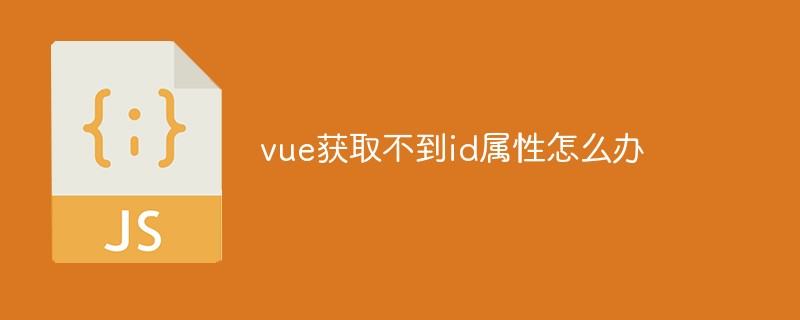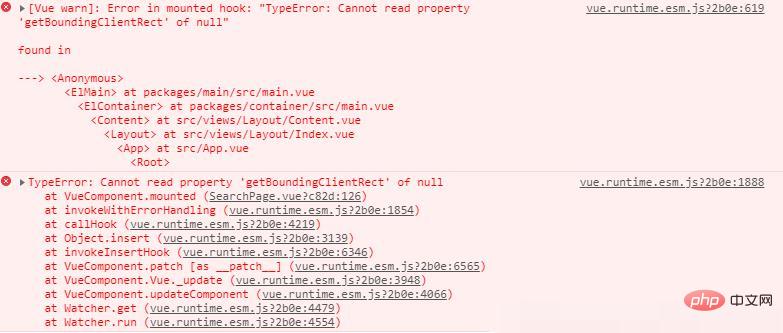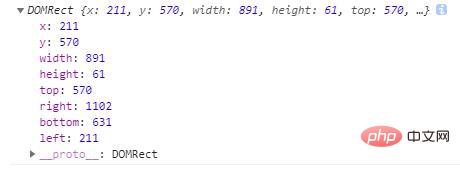Vue cannot obtain the id attribute because getElementById is used in the "created()" hook function, and Vue has not yet completed mounting; the solution is to change "created() {let serachBox = document. getElementById('searchBox');...}" code can be migrated to the "mounted()" hook function.

The operating environment of this tutorial: Windows 10 system, vue3 version, DELL G3 computer
What should I do if vue cannot obtain the id attribute?
The result of using getElementById in Vue is that the returned element is null?
- First of all, I used such a requirement in the project to dynamically calculate the height of the main area based on the client screen size.
When I get this requirement, my first idea is to get the size of the fixed element through element.getBoundingClientRect, and then get the size of the fixed element through document.body.offsetHeight The height of the view area, and finally the size of the main area is dynamically calculated.
Use getElementById in created()
After confirming the idea, I started coding, so I wrote the following code in created:
//此處省去無關(guān)代碼
created()?{
let?serachBox?=?document.getElementById('searchBox');
let?searchRect?=?serachBox?.getBoundingClientRect();
console.log('rect',searchRect?);
let?dffsetHeight?=?document.body.offsetHeight;
this.tHeight?=?(?dffsetHeight?-?searchRect?.bottom?-?100?);},
As a result, the console reported an error directly. The error was as follows: 
According to the error description, I printed the searchBox element upwards. At this time, the console printed the result as null. , this is a bit interesting.
Using getElementById in mounted()
Looking carefully, it turns out that I used getElementById in the created() hook function. At this time Vue has not completed mounting, so it cannot obtain the Dom element through getElementById, so the console prints null. After finding the reason, I migrated the above code to the mounted() hook function, and the console printed the correct result. 
Although the problem was found, the rendering result of the page could not meet my needs. We have to continue to find a way.
Created() is combined with this.$nextTick() to achieve business requirements
Finally created() is combined with this.$nextTick() to achieve business requirements The final code is as follows:
created()?{
this.$nextTick(function?()?{
let?serachBox?=?document.getElementById('searchBox');
let?searchRect?=?serachBox?.getBoundingClientRect();
console.log('rect',searchRect?);
let?dffsetHeight?=?document.body.offsetHeight;
this.tHeight?=?(?dffsetHeight?-?searchRect?.bottom?-?100?);
?})},
Summary
This bug is mainly caused by two aspects.
First, I habitually handle business logic in the created hook function
The second reason is that I am not familiar enough with the life cycle of Vue, and I made a mistake. confused.
Recommended learning: "vue video tutorial"
The above is the detailed content of What should I do if vue cannot get the id attribute?. For more information, please follow other related articles on the PHP Chinese website!

Hot AI Tools

Undress AI Tool
Undress images for free

Undresser.AI Undress
AI-powered app for creating realistic nude photos

AI Clothes Remover
Online AI tool for removing clothes from photos.

Clothoff.io
AI clothes remover

Video Face Swap
Swap faces in any video effortlessly with our completely free AI face swap tool!

Hot Article

Hot Tools

Notepad++7.3.1
Easy-to-use and free code editor

SublimeText3 Chinese version
Chinese version, very easy to use

Zend Studio 13.0.1
Powerful PHP integrated development environment

Dreamweaver CS6
Visual web development tools

SublimeText3 Mac version
God-level code editing software (SublimeText3)
 How to develop a complete Python Web application?
May 23, 2025 pm 10:39 PM
How to develop a complete Python Web application?
May 23, 2025 pm 10:39 PM
To develop a complete Python Web application, follow these steps: 1. Choose the appropriate framework, such as Django or Flask. 2. Integrate databases and use ORMs such as SQLAlchemy. 3. Design the front-end and use Vue or React. 4. Perform the test, use pytest or unittest. 5. Deploy applications, use Docker and platforms such as Heroku or AWS. Through these steps, powerful and efficient web applications can be built.
 Laravel Vue.js single page application (SPA) tutorial
May 15, 2025 pm 09:54 PM
Laravel Vue.js single page application (SPA) tutorial
May 15, 2025 pm 09:54 PM
Single-page applications (SPAs) can be built using Laravel and Vue.js. 1) Define API routing and controller in Laravel to process data logic. 2) Create a componentized front-end in Vue.js to realize user interface and data interaction. 3) Configure CORS and use axios for data interaction. 4) Use VueRouter to implement routing management and improve user experience.
 How to separate the front and back end of wordpress
Apr 20, 2025 am 08:39 AM
How to separate the front and back end of wordpress
Apr 20, 2025 am 08:39 AM
It is not recommended to directly modify the native code when separating WordPress front and back ends, and it is more suitable for "improved separation". Use the REST API to obtain data and build a user interface using the front-end framework. Identify which functions are called through the API, which are retained on the backend, and which can be cancelled. The Headless WordPress mode allows for a more thorough separation, but it is more cost-effective and difficult to develop. Pay attention to security and performance, optimize API response speed and cache, and optimize WordPress itself. Gradually migrate functions and use version control tools to manage code.
 How to push the video stream of Hikvision camera SDK to the front-end Vue project for real-time playback?
Apr 19, 2025 pm 07:42 PM
How to push the video stream of Hikvision camera SDK to the front-end Vue project for real-time playback?
Apr 19, 2025 pm 07:42 PM
How to push video streams from Hikvision camera SDK to front-end Vue project? During the development process, you often encounter videos that need to be captured by the camera to be circulated...
 How to work and configuration of front-end routing (Vue Router, React Router)?
May 20, 2025 pm 07:18 PM
How to work and configuration of front-end routing (Vue Router, React Router)?
May 20, 2025 pm 07:18 PM
The core of the front-end routing system is to map URLs to components. VueRouter and ReactRouter realize refresh-free page switching by listening for URL changes and loading corresponding components. The configuration methods include: 1. Nested routing, allowing the nested child components in the parent component; 2. Dynamic routing, loading different components according to URL parameters; 3. Route guard, performing logic such as permission checks before and after route switching.
 What is the significance of Vue's reactivity transform (experimental, then removed) and its goals?
Jun 20, 2025 am 01:01 AM
What is the significance of Vue's reactivity transform (experimental, then removed) and its goals?
Jun 20, 2025 am 01:01 AM
ReactivitytransforminVue3aimedtosimplifyhandlingreactivedatabyautomaticallytrackingandmanagingreactivitywithoutrequiringmanualref()or.valueusage.Itsoughttoreduceboilerplateandimprovecodereadabilitybytreatingvariableslikeletandconstasautomaticallyreac
 What are the core differences between Vue.js and React in componentized development?
May 21, 2025 pm 08:39 PM
What are the core differences between Vue.js and React in componentized development?
May 21, 2025 pm 08:39 PM
The core differences between Vue.js and React in component development are: 1) Vue.js uses template syntax and option API, while React uses JSX and functional components; 2) Vue.js uses responsive systems, React uses immutable data and virtual DOM; 3) Vue.js provides multiple life cycle hooks, while React uses more useEffect hooks.
 How can internationalization (i18n) and localization (l10n) be implemented in a Vue application?
Jun 20, 2025 am 01:00 AM
How can internationalization (i18n) and localization (l10n) be implemented in a Vue application?
Jun 20, 2025 am 01:00 AM
InternationalizationandlocalizationinVueappsareprimarilyhandledusingtheVueI18nplugin.1.Installvue-i18nvianpmoryarn.2.CreatelocaleJSONfiles(e.g.,en.json,es.json)fortranslationmessages.3.Setupthei18ninstanceinmain.jswithlocaleconfigurationandmessagefil






